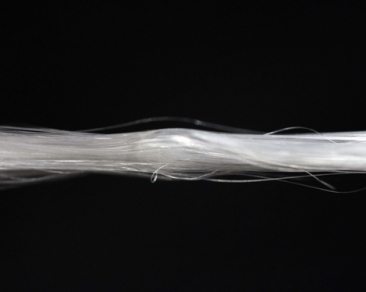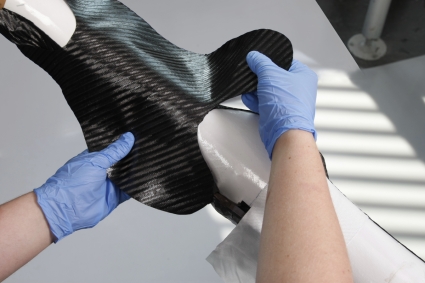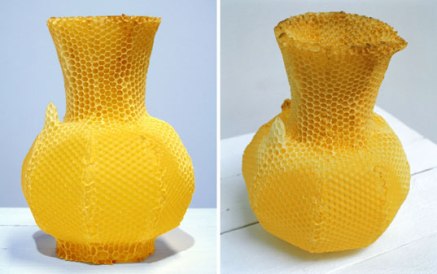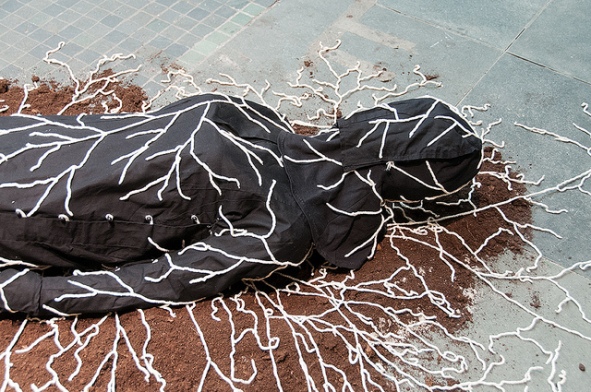Within this lecture I learnt more about synthetic and man made fibres and how these are used within todays textiles. I will also learn more about these non-traditional fibre sources and how they are naturally made. This will be very interesting as last lecture I mainly looked at and discussed natural fibres. Perhaps I can learn about the fibres they use in medical practice within this lecture a little further. Perhaps this lecture will inspire more questions and interests into different textiles that I want to research.
Synthetic Biology
- Investigations into fibre sources from animals and insects is leading to some fascinating results
- Spider silk is the biological engineered fibres currently being investigated via genetic modification in goats or silk worms.
- Scientists took the gene that encodes strong dragline silk from an orb-weaver spider and placed it among the DNA that prompts milk production in goats. This genetic circuit was then inserted in an egg and implanted into a mother goat. When she lactates her milk is full of spider silk protein.
- Stronger than steel or Kevlar
- Produced in the US by Nexia as BioSteel it will initially be used in the medical area.

AMSilk GmbH, (2014), Biosteel Fibre [ONLINE]. Available at:http://www.amsilk.com/en/products/biosteel-spidersilk-fibers.html [Accessed 24 October 14].
‘The biodegradable fabric of Biosteel would need to be sealed from the environment if used in critical applications such as body armor or spacecraft, because it could then be digested.’ -Target Health Global 2014, Milk+Silk = Biosteel. Available from: <http://blog.targethealth.com/?p=20> . [24 October 2014].
Biosteel can also be used for wond closure systems, vascular wond repair devices, homeostatic dressings, patches and glues and other medical devices such as ligament prosthetic devices.
As you can see from my two pieces of research that this material has its positives and negative properties. However it appears in the medical field that this textile is very innovative and creates a great barrier for dressings ect. Being a genetically made natural fibre it is also renewable and environmentally friendly.
Bio Fibres
- Hagfish slime, produced as a protective mechanism has potential in the textile world.
- The hagfish produces a protective slime that expands if a predator bites it. Researchers at the university of Guelph in Canada claims that this has the potential to become a fabric, explaining that when the slime dries out it becomes a silky stretchy substance.
- Protein fibres in the slime are nearly as strong as a spiders silk.
- The long term aim is to find better mechanisms to process natural materials into fibres so that either slime or spider silk could be the next generation of high-performance materials.
Bio Medical Fibres- (Decided to research this myself a little more)
‘Various synthetic and natural fibres, each with unique properties, are used to construct biomedical textiles. Fibres are used in a variety of applications depending on the characteristic required; for example carbon fibre known for its absorption properties is used in wound dressings and absorption columns. However it is used for its strength in artificial ligaments and for its lubricity in orthopaedic cushioning. Synthetic polymers, used extensively, can be divided into permanent e.g. polyamide, polyester, polyethylene, polypropylene, PTFE and polyurethane and biodegradable which are mainly used in sutures and tissue engineering structures e.g. polycaprolactone, polyglycolic acid and polylactic acid. Natural biological fibres include: chitin (from the cells of crustacea) a polysaccharide renowned for its wound healing properties and incorporated into wound dressings; collagen (a fibrous protein found in connective tissue, tendons, etc.) used in cell engineering structures, for example artificial skin; and alginate fibres which can interact with the wound to form an absorbent gel, that acts as a protective barrier and still allows the wound to breathe.’ –
Edinborough &Scottish borders, What are Biomedical Textiles. Available from: http://www1.hw.ac.uk/sbc/BTRC/BTRC/_private/Whatare.htm [24 October 2014]

Unknown, (2012), Innovation in Textiles [ONLINE]. Available at:http://www.innovationintextiles.com/putting-a-spring-in-the-step-of-paralympians/ [Accessed 24 October 14].
As you can see from this little piece of research that biofibres are also used throughout the medical practice. Carbon fibres have absorbing properties and therefore create great characteristics for dressings.
Bio- Materials
- Fibre that show the aesthetics of silk is produced from the casein in milk
- Waste/spoiled milk is still used and turned into a profitable bi-product.
This would mean that nothing is getting wasted and therefore this is a sustainable and environmentally friendly process as nothing gets wasted.
- Has skin friendly properties. It has properties of absorbency and blends well with other fibres.
- It has soft aesthetics and properties with good fluidity and drape.
- Affinity with viscose type fibres.
These Biomaterials are almost Mimicking nature and its systems.
- Protein textiles that can think and are ‘living’ and respond to different actions.
- Silk type fibre from the larvae of the honey bee is 100xfiner than human hair, skin friendly and biodegradable.
- Aiming to create Dissolvable wound dressings that can sense the state of the wound and respond accordingly.
- Linking teams of biologists with textile engineers and medical professions
Bio Materials
- It took 60,000 bees and two months to make Vessel number 1. Created by Tomas Libertiny.
- By using honey bees Libertiny pushes the boundaries of conventional textiles and design by defying mass production and enabling nature to create what would typically be considered a man-made product.
- The material comes from flowers as a by-product of bees, and in this form ends up serving flowers on their last journey.
- Vessel number 1 has the potential to last over 2000 years. Honeycombs containing edible honey were found in Egyptian pharaohs tombs.
Libertiny, T. (2011) Vessel 1 [Online] Available at: <http://www.galleryfumi.com/Artists/Tomas-Libertiny/>. Accessed (24 October 2014)
Growing Fabrics
- Alternative to petrochemicals or plants as a raw material for textile products.
- Biocouture explores growing microbes to create textile/leather type bio material.
- The fermentation of bacteria forms a dense layer, flexible cellulose mat that can then be harvested.
- Takes dye easily and can be printed.
- Safe to compost- feels like vegetable leather.
Bio-materials
- Researching alternatives to synthetic textiles and swapping them with mycelium/fungi to create fabrics and materials.
- Jae Rhim Lee created a ‘death suit’ from fabric embedded with mushroom spores to facilitate speedy decomposition and removal of harmful toxins.
Rhim, J. (2008) Infinity Burial Suit [Online] Available at: <http://infinityburialproject.com/burial-suit>. Accessed (24 October 2014)
Leather alternatives
- Bio-based leather created by Richard Wool from the Univeristy of Delaware made from natural fibres and oils.
- Flax or cotton and plant oils are laminated together in layers to create a breathable leather like material.
- A great improvement on other leather alternatives such as PVC as it’s breathable and very pliable
- A studio in the Netherlands created a sturdy alternative to leather by using leaves of the Areca palm tree. Made by soaking the plant matter in a special biological solution that leaves it supple and pliable. Biodegradable, 100% Vegan friendly. Come in variations of colour. Economic opportunities for artisans in south India where the leaves and the skills to manipulate them are common.
High tech fibres – Carbon Fibre
- Carbon fibre- contains at least 90% carbon obtained by the controlled pyrolysis or decomposition of appropriate fibres, frequently rayon.
- Carbon fibres conductive with heat or power for interactive products and smart textiles.
- A recently coloured version of carbon fibre from hypertext will extend its use.
Earlier in these notes and research I found that carbon fibre was also used in the dress wonds within medical practice. Is this right? Because if it conducts electricity and heat wouldn’t this be dangerous for the wond? Perhaps it only uses a small amount of carbon fibre? I will need to research this further.
Throughout this lecture I have highlighted and jotted down the key textiles and information relating to textiles within medical practice. I have also included some further information I had found on medical textiles and biomaterials within medical practices.
I would like to research this further into more detail looking at the biofibres and materials within medical practice as well as some of the other materials like Alginate that was mentioned within the last lecture. Maybe this will lead me onto other textiles in the medical practice. I am very interested in seeing what properties each textile has and how it help people who are injured or have life risking damages.
Bibliography
Websites
Edinborough &Scottish borders, What are Biomedical Textiles. Available from: http://www1.hw.ac.uk/sbc/BTRC/BTRC/_private/Whatare.htm [24 October 2014]
Target Health Global 2014, Milk+Silk = Biosteel. Available from: <http://blog.targethealth.com/?p=20> . [24 October 2014].
Online Images
AMSilk GmbH, (2014), Biosteel Fibre [ONLINE]. Available at:http://www.amsilk.com/en/products/biosteel-spidersilk-fibers.html [Accessed 24 October 14].
Libertiny, T. (2011) Vessel 1 [Online] Available at: <http://www.galleryfumi.com/Artists/Tomas-Libertiny/>. Accessed (24 October 2014)
Rhim, J. (2008) Infinity Burial Suit [Online] Available at: <http://infinityburialproject.com/burial-suit>. Accessed (24 October 2014)
Unknown, (2012), Innovation in Textiles [ONLINE]. Available at:http://www.innovationintextiles.com/putting-a-spring-in-the-step-of-paralympians/ [Accessed 24 October 14].


